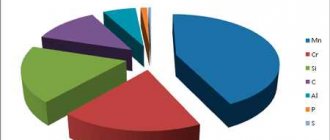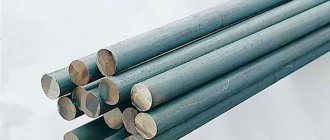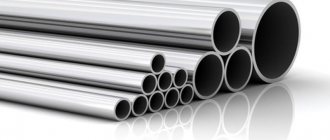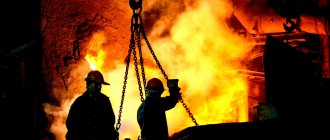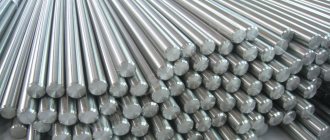According to its characteristics, steel 40X belongs to the group of medium-carbon structural alloy steels. It stands out among others due to its good heat treatment ability. It is one of the most popular grades of metal used in various components of mechanical engineering equipment where increased wear resistance is required. It is highly resistant to corrosion due to its high chromium content.
Normative documents
GOST 82-70. Rolled hot-rolled broadband universal steel. Steel 40X.
GOST 103-76. Hot-rolled steel strip. Assortment. Steel 40X.
GOST 1051-73. Calibrated rolled products. General technical conditions. Steel 40X.
GOST 1133-71. Forged steel round and square. Assortment. Steel 40X.
GOST 1577-93 Rolled thick sheets and wide sheets of structural quality steel. Technical conditions. Steel 40X.
GOST 2590-88. Hot-rolled round steel. Assortment. Steel 40X.
GOST 2591-88. Hot-rolled square steel. Assortment. Steel 40X.
GOST 2879-88. Hot-rolled hexagonal steel. Assortment. Steel 40X.
GOST 7417-75. Calibrated round steel. Assortment. Steel 40X.
GOST 8479-70. Forgings made of structural carbon and alloy steel. General technical conditions. Steel 40X.
GOST 8559-57. Calibrated square steel. Assortment. Steel 40X.
GOST 8560-78. Calibrated hexagonal rolled products. Assortment. Steel 40X.
GOST 10702-78. Rolled products from high-quality structural carbon and alloy steel for cold extrusion and upsetting. Technical conditions. Steel 40X.
GOST 13663-86. Profile steel pipes. Technical requirements. Steel 40X.
GOST 19903-74. Hot rolled sheet products. Assortment. Steel 40X.
GOST 4543-71
When producing steel, manufacturers are guided by GOST 4543-71 standards. It defines the technical conditions for rolled alloy structural steel. Its standards apply to such types of rolled products as ingots, forgings, etc.
GOST 4543-71 gives a clear classification of structural alloy steels. In accordance with it, steel grade 40X belongs to the group of chromium steels.
The same document defines quality parameters, that is, it determines the maximum permissible amount of impurities that affect the technical characteristics of structural alloy steel. Such impurities include sulfur, phosphorus, copper and some others.
By the way, the same document defines the heat treatment regimes for rolled products.
Mass fraction of steel elements 40Х according to GOST 4543-2016
| C (Carbon) | Si (Silicon) | Mn (Manganese) | P (Phosphorus) | S (Sulphur) | Cr (Chrome) | Mo (Molybdenum) | Ni (Nickel) | V (Vanadium) | Ti (Titanium) | Cu (Copper) | N (Nitrogen) | W (Tungsten) | Fe (Iron) |
| 0,36 — 0,44 | 0,17 — 0,37 | 0,5 — 0,8 | < 0,04 | < 0,04 | 0,8 — 1,1 | < 0,11 | < 0,3 | < 0,05 | < 0,03 | < 0,3 | < 0,012 | < 0,2 | rest |
CE = C + Mn/6 + (Cr + Mo +V)/5 + (Ni + Cu)/15. The chemical composition can be changed by agreement. Em = 0.3Cr + 0.5Ni + 0.7Cu. For case-hardened steels, Al > 0.02 is allowed. The content of P may be changed by agreement. As agreed: Ca < 0.003.
Given the complexity of producing this steel, the exact percentage of carbon content is not determined, but ranges from 0.36% to 0.44%. The main alloying additive is chromium, from 0.8% to 1.1%. It is this element that forms the main characteristics of the alloy. Despite the fact that the content of nickel, manganese and silicon is small - up to 1.0%, they affect the properties of steel during the operation of products made from it.
A small copper content (up to 0.035%) does not have a significant effect on the characteristics. The concentration of harmful additives (sulfur, phosphorus) is under strict control.
Application area
Rolled steel 40X is widely used in the engineering industries for the production of products of increased strength and endurance when exposed to intense loads:
- pipes for heating systems;
- disks, rotors for steam turbines;
- crank and cam shafts;
- fasteners.
Sheet steel is used:
- for cold and hot stamping;
- sheathing of frame structures.
From rods manufactured in accordance with GOST 5950-2000, tools are produced that are used at low speeds and temperatures not exceeding 2 thousand degrees.
For the manufacture of main parts for nuclear power plant fittings
The alloy is supplied in the form of lump metal, hot stamped or in the form of fasteners. The use of the final product at temperatures above +500°C is not allowed.
Fittings for nuclear power plants are also made of steel
For valve parts and pneumatic actuators intended for operation at low temperatures
The metal of the parts loses its properties and is not recommended for use at temperatures below -60°C. It is not allowed to use parts with a cross-section of more than 30 mm and a strength of less than 1000 N. Two processing stages are required - calcination and tempering.
Reinforcement parts made of steel
For the manufacture of spindles and rods
The material is supplied in the form of long products. The final product is allowed for use within the temperature range of -40...+450°C, subject to calcination.
Spindle made of steel
For bodies, covers, flanges, membranes and valve assembly made from rolled products, forgings
The form of delivery is lump metal, hot stamped or rolled billets. The alloy retains its structure and properties at ambient temperatures of -40...+450°C.
When used for blocks and reinforcement trunks, the lower temperature threshold is -30°C. Workpieces that have been improved by calcination and high tempering and that have not been welded are allowed for use.
Steel flange
For reinforcement fasteners
The lower limit of the permissible ambient temperature is -60…-40°C. Each product sample is subjected to a Charpy test for the impact of a pendulum pile driver in a place opposite the notch. The result is considered positive if the viscosity to impact load is equal to or exceeds 300 kJ/m.
Steel fasteners
Decoding steel 40X
Grade 40X is classified as structural, alloyed. As a result of the fact that the steel can contain from 0.36 and 0.44% carbon and from 0.8 to 1.1% chromium, it becomes difficult to weld. That is, to obtain a high-quality seam it is necessary to perform a number of additional technological operations. Before welding begins, the edges of the parts must be heated to 300 ºC. After the seam is obtained, annealing must be performed.
Full composition of 40X:
| C(carbon) | Si(silicon) | Mn(manganese) | Ni(nickel) | S(sulfur) | P(phosphorus) | Cr(chrome) | Cu(copper) |
| 0,36-0,44 | 0,17-0,37 | 0,5-0,8 | up to 0.3 | up to 0.035 | up to 0.035 | 0,8-1,1 | up to 0.3 |
The chemical composition of 40X steel allows it to be used for the production of parts with high strength parameters. These details include:
- mechanism shafts;
- axles;
- spindles;
- gear rings, etc.
Fittings, channel price
Operating on the market since 1997, it ships large quantities of about 1,000 tons monthly. High-quality metal products (sheets, fittings, channels ) with a wide geography of supplies - from Kaliningrad to Sakhalin. As a result, hundreds of facilities throughout Russia are provided with high-quality rolled metal products for a wide variety of needs. Both large companies and individuals can buy rolled metal (rebar, channel, sheet) in the city of Yekaterinburg. All rolled metal products sold from the warehouses of our organization are certified by manufacturing plants and comply with GOST and TU.
Working with you get:
- high quality products
- professional selection of products in accordance with the necessary requirements
- service from qualified company personnel
- favorable payment terms
- Providing discounts and trade credits to regular customers
- possibility of carrying out individual orders
- the ability to choose from the company’s highly liquid warehouse stocks
- shipment in the shortest possible time on a pick-up basis, as well as by road, rail and river transport to your warehouse
Chemical composition
Throughout the CIS, the characteristics and use of 40X steel are determined by GOST 4543-2016. It indicates the chemical composition and basic performance properties. Decoding the steel indicates the content of the main components - carbon and chromium.
The first two characters indicate the concentration of the main alloying element - carbon, it is in the range of 0.36-0.40%. It is difficult to maintain a more precise concentration during the metal smelting process.
The letter "X" indicates the presence of chromium, which improves the corrosion resistance of the material. However, its concentration does not exceed 0.8-1.1% and is insufficient to impart sufficient corrosion resistance to steel.
The alloy also contains other alloying additives that are not indicated in the markings, but impart certain properties to 40X steel:
- nickel – up to 0.3%;
- manganese – 0.5-0.8%;
- silicon – 0.17-0.37%;
- copper is present in very small quantities, about 0.035%, and does not significantly affect the mechanical properties of the alloy;
- The concentrations of harmful impurities - sulfur and phosphorus - are strictly regulated; their content does not exceed 0.035%.
Rolled metal (channels, fittings, sheets)
Sale and shipment of metal from warehouses is carried out in quantities of one piece. Custom products, such as sheet cutting, are shipped from factories in accordance with the minimum batch standards of manufacturing plants. More detailed information about the sizes of minimum quantities, discounts and required delivery times for rolled metal products to Yekaterinburg can be promptly obtained from our managers.
The company has established itself as an exceptionally reliable partner in the supply of rolled metal products ( beams ). When working with our clients, we use an exclusively individual approach and provide truly competitive prices. Prompt work with metal manufacturing plants, the necessary service directly at shipping sites, freight forwarding, a flexible system of discounts - this is not a complete list of competitive advantages. The full implementation of all these principles, combined with a responsible attitude to our obligations, are the key to successful cooperation with our clients.
To order the rolled metal you need (reinforcement, beams, channels, cutting sheets), just call our numbers in Yekaterinburg or send an email to [email protected] Both cash and non-cash payments are possible. Plastic cards of all standards are also accepted for payment.
We invite you to visit the pages of the catalog of rolled metal and pipes: steel pipe, steel sheet, expanded metal.
Advantages and disadvantages
The pros and cons of a material are determined by its properties. Among the characteristics of 40X steel, hardness and endurance are of particular importance. Due to the presence of chromium in the alloy, parts made from it:
- have a high margin of strength and corrosion resistance;
- designed for high and long-term loads;
- resistant to extreme temperatures in the range from -40 to +425 degrees;
- withstand sudden temperature changes; the magnetic properties of 40X steel do not affect its performance characteristics;
- can be used in almost any external conditions;
- do not require cleaning or surface treatment;
- have a high limit of endurance and resistance to warping.
After hardening, the carbide contained in the alloy is completely dissolved, and the metal acquires higher corrosion resistance.
The chemical properties of 40X steel allow it to be used in aggressive wet environments. The material also lends itself well to cutting operations. In terms of weldability, the alloy belongs to group 4.
To avoid cracks in the welding seam, it should be preheated to 200-300 degrees.
Disadvantages of steel include temper brittleness and flake sensitivity, however, heat treatment technologies make it possible to reduce these properties to minimal values.
Application area
According to the degree of weldability of the structure, it belongs to group 4. The weld seam can cause various cracks to form. That is why the 40X material is preheated before performing welding work, which avoids simply a huge number of problems with the operation of the resulting product.
In addition, it is necessary to carry out preliminary preparation of the edges for arc welding. When using contact point technology, heat treatment is required.
Other properties of the material in question determine its wide application. The following types of workpieces are supplied to production sites:
- Sheets. Sheet metal is widely used, for example, in cold or hot stamping. In addition, metal sheets are used for sheathing frame structures.
- Forgings are used as a basis for creating various products.
- Pipes are very common today, for example, when creating a heating system or for transporting various liquids.
- Rolled metal is used in the mechanical engineering field as a blank for various parts.
Circle f 160 st 40X with turning
After heat treatment, Steel 40 can be used to produce nozzles, reamers and tap bodies. An analogue of 40X steel can be used to produce various critical structures, for example, axles, shafts, gears, bolts or plungers. Foreign analogues can be used to manufacture parts that will be used outdoors at low temperatures. An example is the elements of bridges and railway structures.
To significantly increase the performance characteristics of the resulting products, various heat treatments are carried out.
Hardening leads to a significant increase in surface hardness, but brittleness can only be reduced by tempering. It is possible to achieve the required indicators only if the specific features of the technology are observed.
Characteristics
The characteristics of 40x steel include:
- hardness;
- density;
- yield/strength strength;
- impact strength, etc.
Critical point temperature
| Critical point | °C |
| Ac1 | 743 |
| Ac3 | 815 |
| Ar3 | 730 |
| Ar1 | 693 |
| Mn | 325 |
Hardness
Steel hardness (hb - hrc) can be expressed in different numerical values, depending on the measurement scale:
- According to Rockwell, the technique is based on measuring the depth of penetration of an indenter (hard tip) into the material under study. The hardness on this scale is 217 MPa.
- According to Brinell, the indenter is pressed into a metal sample for 2-8 seconds (the load is gradually increasing) and the diameter of the resulting indent is measured. Balls made of durable alloys with a diameter of 1 to 10 mm are used as indenters. The Brinell hardness of steel 40x is 187 MPa.
- In the melting state, the hardness during the melting period fluctuates within 18 MPa.
Note! The harder the steel, the less strength it has. In the first case, it is impossible (or difficult) to scratch it with anything, in the second, it can be damaged even from a light blow (this is insufficient strength).
Density
The density of steel 40x is 7820 kg/m³. The density of a substance is a constant value, and is measured using the hydrostatic method - a sample is weighed in air and then in water, and its density (the ratio of body mass to volume) is calculated. The liquid used as a measurement must wet the material well, but not react with it. Therefore, distilled water is used for weighing.
Brand
This grade implies a steel content of 0.40% carbon and about 1.5% chromium.
Possible substitutes are 45Х, 38ХА, 40ХС, etc. Class: structural alloy. Type and condition of delivery:
- long products (including shaped);
- rod and silver;
- the leaf is thick;
- pipes, etc.
The term “structural” indicates that metal is used for the manufacture of various structures, mechanisms and parts, for example, in the field of construction and mechanical engineering.
Tensile strength
The tensile strength is understood as the mechanical stress above which the material is destroyed or deformed. The maximum strength of steel at the moment of bending is 509 MPa, and at temporary resistance - 960 MPa.
This indicator is measured using tensile and deformation tests. In this case, not only the tensile strength is determined, but also elongation, temporary resistance, etc.
Weldability
| No limits | Limited | Difficult to weld | |
| Heating | No | up to 100–1200С | 200–3000С |
| Heat treatment | No | There is | annealing |
Yield strength
The physical yield strength is the stress value at which the deformation of the material under test increases without additional load. The yield strength of steel 40x is 785 N/mm2. The final result is influenced by various factors:
- metal thickness;
- heat treatment mode;
- the presence of impurities in the product;
- crystal lattice defects, etc.
Strength
Strength is the resistance of a metal to external loads. To find out what the strength of steel is, tests are carried out on special machines with different power levels. The latter consist of a loading mechanism that creates force, and are either mechanical or hydraulic.
Steel 40x has high strength - 271 MPa. It is also able to maintain structure under heavy loads.
Tendency to temper brittleness
Prone.
Endurance limit
| σ-1, MPA | J-1, mPa | n | Steel condition |
| 363 | 240 | 106 | σв=690 MPa |
| 470 | 106 | σв=690 MPa | |
| 509 | 5*106 | σ0.2=690 MPa, σв=690 MPa | |
| 333 | σв=690 MPa | ||
| 372 | Quenching 860 °C, oil, tempering 550 °C |
Impact strength
The impact strength of this brand is 400 – 850 kJ/sq. m. Tensile strength is 980 N/m2. Impact toughness refers to the ability of a metal to absorb mechanical energy generated during the process of destruction and deformation.
Hardenability of steel according to GOST 4543-71
| Distance from the end, mm | Note | |||||||||
| 1,5 | 4,5 | 6 | 7,5 | 10,5 | 13,5 | 16,5 | 19,5 | 24 | 30 | Hardening 860 °C |
| 20,5-60,5 | 48-59 | 45-57,5 | 39,5-57 | 35-53,5 | 31,5-50,5 | 28,5-46 | 27-42,5 | 24,5-39,5 | 22-37,5 | Hardness for hardenability strips, HRC |
Forging
| Type of semi-finished product | t, 0С | Cooling | |
| Section size | Conditions | ||
| mm | |||
| Ingot | 1250–800 | ||
| Blank | up to 350 | On air | |
cutting
| Initial data | Machinability Ku | |||
| State | HB, MPa | sB, MPa | hard alloy | high speed steel |
| hot rolled | 163–168 | 620 | 1,2 | 0,95 |
Welding
| Weldability | Welding methods | Recommendations |
| Difficult to weld | ESH, RDS, KTS | Heating + heat treatment |
Flock sensitivity
Sensitive.
Selecting a coating for a stainless steel part
You're damn smart. It's actually an acronym.
I take my hat off to the experienced specialist. I didn’t expect that such a designation for stainless steel would confuse anyone. In the area where I work it is generally accepted.
As far as I understand, no one knows about the coverage. As they said in one old program, “the money goes to the viewer, the experts lose.” There is information that it is necessary to coat Ts9 Chem.Phos.prm.
Offtop: The 90-9-1 rule of thumb, somewhat similar to the Pareto Rule (20/80), describes the ratio between the number of people who will participate in a community, comment and simply read. According to it, 1% or less of people will create new content, 9% will edit or comment on it, and 90% will just silently read it without any participation. The rule also states that for every active participant in an online forum, 99 people will simply read his message.
Is it true? Of course, the exact ratio will vary, for example, as Aqil Awan's research on the radical jihadist forum showed, 87% of users wrote nothing, 13% wrote at least once, 5% wrote 50 or more messages, and only 1% left more than 500 messages. But even with an invitation system and closed registration, creators will still be in the minority. This conclusion was reached by Michael Wu, who analyzed the unevenness of participation in hundreds of communities divided by field of activity and type of audience.
Source
Heat treatment of steel 40Х
One of the key characteristics of metal is hardness, that is, the ability to resist the penetration of other, harder materials into it. The level of hardness determines the possibility of using metal in the production of certain machine parts and mechanisms.
The hardness of the metal has a direct impact on:
- Strength;
- Resistance to wear and a number of others.
A process engineer, when selecting metal processing modes from 40X steel, is guided, among other things, by hardness parameters. To change the hardness parameter, heat treatment is used.
In addition, it is necessary to improve the mechanical properties of both individual parts and the structure as a whole. As delivered, the hardness of 40X steel is 217 MPa - according to Brinell. To increase it, various heat treatment methods are used.
In particular, for 40X the following hardening methods are used:
- single refrigerant;
- two refrigerants;
- coolant jets;
The first method implies that one type of coolant will be used (water, oil, etc.).
The second assumes that after cooling the workpiece in water, it is sent to oil.
The third method is based on directing a jet of coolant (oil, water) onto the heated part of the part. This method is used if there is a need to harden a certain part of a part, for example, the crown of a gear wheel. In addition, this technology is distinguished by the fact that during the processing there is no “steam” jacket and this has a positive effect on the quality of hardening.
During the heat treatment process, problems arise in protecting the part from defects that may appear after scale has appeared (a consequence of exposure to oxygen) or carbon burnout. To prevent this, the chamber in which the workpiece is heated is saturated with gas, which is a product of methane combustion. In fact, protecting the workpiece from exposure to atmospheric oxygen is an important task.
By the way, heat treatment of products made of 40X steel is best carried out in a hermetically sealed oven. Sometimes, cast iron shavings are used to isolate a part from the influence of foreign factors during processing in a furnace. That is, the workpiece is covered with cast iron shavings or crumbs.
Industrial use
Steel 40X is used in the manufacture of high-strength parts of mechanisms and structures. These include:
- shafts,
- axles,
- gear shaft,
- stocks,
- plungers,
- crankshafts and camshafts,
- spindles,
- rings,
- mandrels,
- ring gears,
- bolts,
- slats,
- bushings.
40X steel is popular in construction, shipbuilding, mechanical engineering, and medicine. Knives are made from 40X steel, including medical scalpels. It is completely safe for the human body, so it can be used in the manufacture of medical instruments.
40X steel is rarely used for the manufacture of welded structures due to the limited weldability of the alloy, which requires preliminary and subsequent heat treatment of the product.
Alloy properties
The physical and mechanical properties of 40X steel allow it to withstand high loads without destroying its structure:
- density – 7820 kg/m3; elastic modulus – 2.14Х10-5;
- coefficient of linear expansion – 11.9Х106 1/deg.;
- electrical resistivity – 210Х109 Ohm*m;
- impact strength – 160 J/cm2;
- forging temperature – from 1250 to 800 degrees.
Almost all indicators change depending on temperature. As it increases, the following increases:
- resistivity;
- linear expansion coefficient;
- specific heat.
The inverse dependence on temperature is demonstrated by:
- elastic modulus;
- metal density;
- coefficient of thermal conductivity.
An important characteristic is the yield strength indicator. It is determined by the magnitude of the load at which irreversible deformations occur in the product. The indicator depends on several factors: heat treatment mode; type of alloying additives and amount of harmful impurities; crystal lattice structure.
For steel 40X, the yield strength decreases in the temperature range of 100-500 degrees from 490 to 345 MPa. Tempering brittleness and flake sensitivity have a negative impact on the quality of the alloy. Steel is difficult to weld and requires preheating and subsequent heat treatment.
Reinforcement - channel - beam
offers its customers rolled metal: fittings , channels, beams, as well as stainless pipe and stainless steel sheets produced in Russia and China in Yekaterinburg. In our company you can buy the following types of rolled metal:
In addition, it provides the following types of services:
- cutting metal sheets to customer sizes
- chamfering pipes
- sheet cutting on CNC machines
- shipment of prefabricated vehicles, wagons and containers
Heat treatment
| Heat treatment modes | ||||||||
| 1 option | Wednesday | t, 0С | Option 2 | Wednesday | t, 0С | Option 3 | Cooling medium | t, 0С |
| Annealing | with oven | 820–840 | Normalization | air | 850–870 | Hardening | oil/water | 840–875 |
| Vacation | 560–650 | Vacation | air/ water/ oil/ oven | 450–650 | ||||
Brand of steel and alloys
Types of supply of material 40Х
| B03 - Metal forming. Forgings | GOST 8479-70; |
| B22 – Long and shaped rolled products | GOST 9234-74; GOST 1133-71; GOST 11474-76; GOST 2879-2006; GOST 2591-2006; GOST 2590-2006; |
| B23 - Sheets and strips | GOST 103-2006; GOST 19903-74; GOST 82-70; |
| B32 – Long and shaped rolled products | GOST 8560-78; GOST 8559-75; GOST 10702-78; GOST 7417-75; GOST 4543-71; GOST 1051-73; GOST 14955-77; |
| B33 - Sheets and strips | GOST 1577-93; |
| B62 — Steel pipes and connecting parts for them | GOST 24950-81; GOST 23270-89; GOST 7909-56; GOST 9567-75; GOST 8734-75; GOST 8733-74; GOST 8732-78; GOST 8731-87; GOST 53383-2009; |
| B71 – Low carbon steel wire | GOST 1526-81; |
Chemical composition in % of material 40Х
GOST 4543 - 71 C Si Mn Ni SP Cr Cu0.36 - 0.440.17 - 0.370.5 - 0.8 to 0.3 to 0.035 to 0.0350.8 - 1.1 to 0.3
The temperature of the critical points of the material is 40X.
Ac1 = 743, Ac3(Acm) = 782, Ar3(Arcm) = 730, Ar1 = 693
Technological properties of material 40Х.
| Weldability: | difficult to weld. |
| Flock Sensitivity: | sensitive. |
| Tendency to temper brittleness: | inclined. |
Mechanical properties at T=20oC of 40X material.
| Hardness 40X after annealing, GOST 4543-71 | HB 10 -1 = 217 MPa |
| Hardness 40X, Pipes GOST 8731-87 | HB 10 -1 = 269 MPa |
| Hardness 40X, Cold-deformed pipes. GOST 8733-74 | HB 10 -1 = 217 MPa |
| Hardness 40X, hot rolled rod. GOST 10702-78 | HB 10 -1 = 179 MPa |
Physical properties of material 40X.
| T | E 10- 5 | a 10 6 | l | r | C | R 10 9 |
| hail | MPa | 1/Grad | W/(m deg) | kg/m3 | J/(kg deg) | Ohm m |
| 20 | 2.14 | 7820 | 210 | |||
| 100 | 2.11 | 11.9 | 46 | 7800 | 466 | 285 |
| 200 | 2.06 | 12.5 | 42.7 | 7770 | 508 | 346 |
| 300 | 2.03 | 13.2 | 42.3 | 7740 | 529 | 425 |
| 400 | 1.85 | 13.8 | 38.5 | 7700 | 563 | 528 |
| 500 | 1.76 | 14.1 | 35.6 | 7670 | 592 | 642 |
| 600 | 1.64 | 14.4 | 31.9 | 7630 | 622 | 780 |
| 700 | 1.43 | 14.6 | 28.8 | 7590 | 634 | 936 |
| 800 | 1.32 | 26 | 7610 | 664 | 1100 | |
| 900 | 26.7 | 7560 | 1140 | |||
| 1000 | 28 | 7510 | 1170 | |||
| 1100 | 28.8 | 7470 | 120 | |||
| 1200 | 7430 | 1230 | ||||
| T | E 10- 5 | a 10 6 | l | r | C | R 10 9 |
Foreign analogues of material 40X
Attention! Both exact and closest analogues are indicated.
| USA | Germany | Japan | France | England | European Union | Italy | Belgium | Spain | China | Sweden | Bulgaria | Hungary | Poland | Romania | Czech | Australia | South Korea |
| — | DIN,WNr | JIS | AFNOR | B.S. | EN | UNI | NBN | UNE | G.B. | SS | BDS | MSZ | PN | STAS | CSN | AS | KS |
| 5135 | |||||||||||||||||
| 5140 | |||||||||||||||||
| 5140H | |||||||||||||||||
| 5140RH | |||||||||||||||||
| G51350 | |||||||||||||||||
| G51400 | |||||||||||||||||
| H51350 | |||||||||||||||||
| H51400 |
| 1.7035 |
| 1.7045 |
| 37Cr4 |
| 41Cr4 |
| 41CrS4 |
| 42Cr4 |
| SCr435H |
| SCr440 |
| SCr440H |
| 38C4 |
| 38C4FF |
| 41Cr4 |
| 42C4 |
| 42C4TS |
| 41Cr4 |
| 530A36 |
| 530A40 |
| 530H36 |
| 530H40 |
| 530M40 |
| 1.7035 |
| 1.7039 |
| 37Cr4 |
| 37Cr4KD |
| 41Cr4 |
| 41Cr4KD |
| 41CrS4 |
| 36CrMn5 |
| 37Cr4 |
| 38Cr4KB |
| 38CrMn4KB |
| 41Cr4 |
| 41Cr4KB |
| 38Cr4 |
| 38Cr4DF |
| 41Cr4 |
| 41Cr4DF |
| 42Cr4 |
| F.1201 |
| F.1202 |
| F.1210 |
| F.1211 |
| 38CrA |
| 40Cr |
| 40CrA |
| 40CrH |
| 45Cr |
| 45CrH |
| ML38CrA |
| ML40Cr |
| SCr435H |
| SCr440 |
| SCr440H |
| Mechanical properties : | |
| sв | — Short-term strength limit, [MPa] |
| sT | — Proportional limit (yield strength for permanent deformation), [MPa] |
| d5 | — Elongation at break, [%] |
| y | — Relative narrowing, [%] |
| KCU | — Impact strength, [kJ/m2] |
| HB | — Brinell hardness, [MPa] |
| Physical properties: | |
| T | — Temperature at which these properties were obtained, [Deg] |
| E | — Modulus of elasticity of the first kind, [MPa] |
| a | — Coefficient of thermal (linear) expansion (range 20o - T), [1/degree] |
| l | — Thermal conductivity coefficient (heat capacity of the material), [W/(m deg)] |
| r | — Material density, [kg/m3] |
| C | — Specific heat capacity of the material (range 20o — T), [J/(kg deg)] |
| R | — Electrical resistivity, [Ohm m] |
| Weldability: | |
| no limits | — welding is performed without heating and without subsequent heat treatment |
| limited weldability | — welding is possible when heated to 100-120 degrees. and subsequent heat treatment |
| difficult to weld | — to obtain high-quality welded joints, additional operations are required: heating to 200-300 degrees. during welding, heat treatment after welding - annealing |
40Х - Structural alloy steel 40Х - chemical composition, mechanical, physical and technological properties, density, hardness, application
When using site information, a hyperlink to “Brand of steel and alloys (www.splav-kharkov.com)” is required on each page. Legal support for the resource is provided by legal. company "Internet and Law"
Analogues and nomenclature
Steel grade 40X can be replaced with domestic analogues:
- 45X;
- 38ХА;
- 40ХН;
- 40ХС;
- 40HF;
- 40XP.
Foreign analogues have different markings, but the compositions of these alloys are approximately the same:
- G51400 and H51350 - United States;
- 37Cr4, 41Cr4, 41CrS4 – Germany;
- 35Cr, 38CrA, 40Cr and 40CrA – China;
- SCr435, SCr440 – Japan;
- 37Cr4, 41Cr4 – France;
- 36CrMn4 – Italy;
- 2245 – Sweden;
- 14140 – Czech Republic.
The classification of structural alloy steels is regulated by GOST 4543-71. It specifies technical conditions for different types of rental. According to the characteristics of steel 40X, GOST 4543-71 classifies it as chromium alloys and establishes:
- maximum content of impurities that negatively affect the technological properties of the material, for example, sulfur and phosphorus;
- heat treatment modes.
Steel is supplied in the form of:
- long products according to several standards;
- calibrated rod;
- ground and silver rod according to GOST 14955-77;
- thick sheet and strips;
- forgings, according to GOST 8479-70;
- pipes and connecting parts to them.
Technical characteristics of steel 14Х17Н2
Steel 40X - domestic analogues
| Rolled metal grade | Substitute |
| 40X | 38ХА |
| 40ХН | |
| 40ХР | |
| 40ХС | |
| 40HF | |
| 45X |
Foreign analogues
Analogues of the 40X alloy are also produced in other countries. Their labeling differs from the Russian one, but the composition is almost identical. Such alloys include:
- 41Cr4, 41Cr54 (Germany);
- S140, S140H (America);
- 41Cr4, 42C4 (France);
- S30A40, S30H40, S30M40 (UK);
- SS2245 (Sweden);
- 41Cr4, 41Cr4KB (Italy);
- SCr435-H, SCr440 (Japan);
- 40H (Poland).
Among the range of steels presented by Russian manufacturers, there are no complete analogues of grade 40X. But there are metals that are similar in composition and in their performance characteristics. These include:
- 45X;
- 38ХА;
- 40ХН;
- 40ХС;
- 40HF;
- 40XP.
The possibility of replacement should be determined only after an assessment and comparison of the properties of different steel grades.
Application area
Rolled steel 40X is widely used in the engineering industries for the production of products of increased strength and endurance when exposed to intense loads:
- pipes for heating systems;
- disks, rotors for steam turbines;
- crank and cam shafts;
- fasteners.
Sheet steel is used:
- for cold and hot stamping;
- sheathing of frame structures.
From rods manufactured in accordance with GOST 5950-2000, tools are produced that are used at low speeds and temperatures not exceeding 2 thousand degrees.
Application of 40X steel in industry and everyday life
As noted above, 40X is classified as an alloyed structural material. This is what allows it to be used in the automotive industry, as carburetor needles, spring products, etc. are produced from it. In addition, forgings and parts of pipeline fittings are produced from this material. But it is necessary to remember that all these parts must undergo heat treatment. In particular, they are hardened in oil and released in it.
In mechanical engineering, 40X steel is used for the production of technological equipment, including measuring equipment, compressor parts and much more.
Steel 40X and its substitutes have found their application in everyday life. In particular, kitchen utensils, in particular knives, are made from it. They are easy to sharpen and are not subject to corrosion. Knives made from this material can be used when cutting any products - meat, poultry, vegetables, fruits. We can safely say that 40X steel is harmless to the human body.
This is what makes it possible to use grade 40X steel and its derivatives for the manufacture of medical instruments, for example, medical scalpels and other surgical instruments.
But, in addition to a number of undeniable advantages, 40X steel also has a number of technological disadvantages. Thus, this material has low resistance to aggressive environments and high temperatures.
To obtain parts of different shapes, various metalworking methods are used, including turning, milling, and grinding. 40X steel can be classified as a material that does not require any special tools for processing.
Samples of products made from steel 40Х
Below are samples of some products manufactured by our organization from 40X steel.
Input gear shaft of the RM-650 gearbox">
Gear wheels of the Ts2U-315N reducer">
Output shaft in the form of a gear coupling half of the RM-350 gearbox">
Sources
- https://vse-stali.ru/stal-konstruktsionnaya/legirovannaya-stal-konstruktsionnaya/stal-40h/
- https://intehstroy-spb.ru/spravochnik/ctal-40h.html
- https://prompriem.ru/stati/stal-40x.html
- https://metal.place/ru/wiki/40kh/
- https://www.lsst.ru/spravochnik-metalloprokata/konstruktsionnaya-stal/stal-40kh/
- https://molotok34.ru/spravochnik/stal-40-h.html
- https://xlom.ru/spravochnik/stal-40h
- https://nzmetallspb.ru/osnastika/stal-40h-harakteristiki-tverdost-primenenie.html
- https://punktpriema.ru/articles/tehnicheskie-harakteristiki-stali-40h.html
Analogs
40X - very common in its characteristics. The most famous are the following foreign analogues:
- USA, Canada – 5140, G51400$
- European Union – 1.7035, 37Cr4, 41Cr4;
- Japan – SCr440;
- China – 40Cr, 40CrA.
Technical requirements are established by national and DIN standards.


